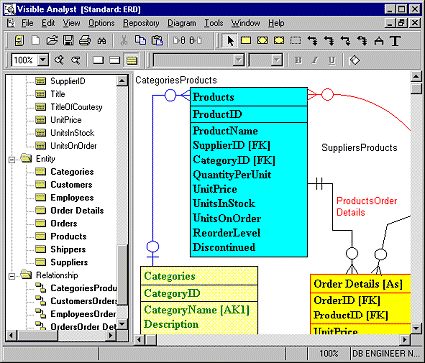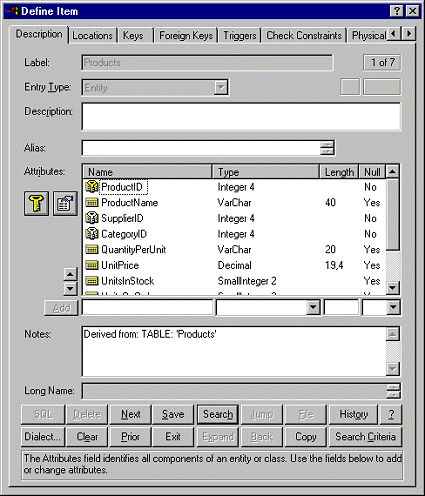 |
Visible Analyst Standard |
The Visible Analyst Standard edition focuses on the structured modeling methods (data flow diagrams, decomposition diagrams, structure charts, entity life history) and database engineering. It automates all of the traditional structured methods and forward and reverse engineered databases via ODBC, direct native connection, or SQL. This new edition represents a compatible feature set to the recently discontinued EasyCASE Professional plus Database Engineer (DBE) add-on tool - delivering superior capabilities at a lower price than any of its competition. The Standard edition is for Systems Analysts who want to automate structured modeling techniques.
Key Features of Visible Analyst Standard
- Multi-user concurrent access enables team collaboration.
- Smart Reverse Engineering - Reverse engineering analyzes legacy databases to find relationships not expressly defined to the database. Allows the tool to "infer" relationships where none is defined.
- Object Browser - Allows easy navigation and manipulation of all entities, attributes and relationships in the repository.
- Forward and reverse engineering through ODBC, direct connection or SQL DDL for virtually all databases.
- Generates AS/400 DDS.
- Methodology and rules checking support for SSADM, Metrica, Gane/Sarson, and Yourdon/Demarco.
- Web publish models (reports and diagrams) for sharing across the Internet with standard HTML and JPEG formats.
Database Design Modeling
Visible Analyst Standard edition supports entity-relationship diagrams (ERDs) based on data modeling notations defined by IDEF1X, Bachman, and Information Engineering (IE). ERDs can be automatically generated from the data dictionary and Repository information and generate multiple views based on Subject Area, Functional area, or any user selected set of Entities and associations. Visible Analyst automatically synchronizes cascaded foreign keys, and dynamically maintains syntactically correct ERDs. In addition, Visible Analyst Standard edition interactively checks and resolves normalization problems and provides key analysis. Multiple display options include entity, entity/key, entity/attribute, and entity/attribute-physical. Detailed Entity and Business Rules Reports can be generated.
Process Modeling
Visible Analyst Standard edition supports the techniques and notations for Yourdon/DeMarco, Gane & Sarson, SSADM and Metrica methodologies. Processes and data stores are automatically numbered (Gane & Sarson) on data flow diagrams (DFDs). Visible Analyst enables "top-down" and "bottom-up" analysis and design approaches. Balancing, leveling, syntax, and completeness are interactively checked and resolved and data flows are automatically balanced. In addition, Visible Analyst automatically populates the integrated Repository and supports splitting of data flows from Repository definitions. Process decomposition diagrams are automatically generated.
The following process modeling and design techniques are supported:
- Data Flow Diagrams (DFDs) business process & systems analysis modeling with automatically derived decompositions
- Functional Decomposition Diagramming (FDDs)
- Structure Chart Application Design Modeling
- Entity Life History (ELH) Diagrams including SSADM & Metrica methodologies
Business Modeling
Visible Analyst Standard edition supports the modeling business functions and system processes and is fully integrated to support FDDs through an integrated repository (including auto-generation of DFDs from FDDs with automatic process balancing). The functional decomposition techniques of IE (Martin) methodology is completely supported. Automatic connection of functions and processes to subsidiary functions and processes are supported. Intelligent page connectors are available for large models. Validation of completeness and consistency of functions and processes are supported.
Structured Design Modeling
Visible Analyst Standard edition supports Structure Design Modeling for Yourdon/Constantine and Page-Jones methods and automatically populates an integrated Repository. This model integrates with data flow models and includes syntax and completeness checking. Modules, Macros, and Library Modules are supported; and the Standard edition allows for control of both couples and data couples. Multiple invocation techniques can be specified including direct, in-line, decision, and pathological. Design complexity and structure of charts can be measured. Information clusters, interface tables, and intelligent page connectors for large diagrams are also supported.
State Event Modeling with Entity Life History Diagrams
Visible Analyst Standard edition supports Metrica and SSADM methodologies using entity life history diagrams (ELHs) for modeling events in a system. The ELH diagram shows how events in a system affect data entities. An ELH applies to a single entity that originates on a logical data structure diagram. There can be an ELH diagram for each entity on a logical diagram. An ELH diagram is derived from the Jackson structure diagram and represents the processing performed on the data depicted by an entity.
Database Schema Generation & Forward / Reverse Engineering of Existing Databases
Visible Analyst Standard edition can generate databases schemas directly from your ERDs via ODBC or SQL DDL scripts. The Standard edition helps you develop quality client/server applications, with support for domains (user defined data types), stored procedures, triggers (with referential integrity trigger generation), indexes, primary keys, and foreign key referential integrity constraints on applicable databases.
Visible Analyst Standard edition enables schema generation and reverse engineering of a wide range of popular desktop and client/server databases. You can connect directly to the target database via drivers that conform to Microsoft's Open Database Connectivity (ODBC) standard, native drivers for many popular databases, or generate SQL DDL via a text file and have the database process it.
Visible Analyst Standard edition gives you the ability to read and under-stand the structure of the existing database system, which saves time and increases accuracy. Once the database has been reverse-engineered, you can automatically generate ERDs to reflect its structure. Then you can update the created model and regenerate it using the same or different database type. When you reverse engineer, you capture structures of tables, indexes, primary keys, foreign keys, stored procedures, triggers, and physical storage parameters.
Repository, Networking, and Reporting Features
The Visible Analyst Standard Repository functions interactively with the diagramming and rules to automatically create an organized database of project information for each project as it is developed. The Repository is automatically updated and maintained during all of your work sessions and it can be accessed at any time to manually add, delete, edit or review entries. The multi-user functionality permits concurrent access, simultaneous update, and row level locking.
Visible Analyst Standard edition supports a variety of comprehensive repository reports based on the current project repository and other project information. Custom Repository reporting capabilities are also supported. The Standard edition supports report preview (using your Internet browser), print to file, or printer. Web publishing of reports and diagrams for sharing across the Internet in standard HTML and JPEG formats are also supported.
Database Types Supported
- Access
- ANSI SQL-92
- Centura SQLBase
- DB2 2.x, 5.x, 6.x, 7.x, 8.x
- DBASE IV SQL
- Datacom SQL
- Informix SQL
- Ingres SQL
- Netware SQL
- Oracle 7.x, 8.x, 9.x, 10.x
- Paradox
- Progress 7.x, 8.x Native 7.x, Native 8.x
- Rdb SQL
- SQL Server 4.x, 6.x, 7.x, 2000, 2000 Ent., 2005 Ent.
- Server System 10/11
- Teradata SQL V2 R2
- Unify SQL
- Watcom/ SQL Anywhere
- XDB SQL
- Popular desktop DBs via ODBC... and customizable dialects

Visible Analyst has a convenient Object Browser (left) from which you can drag and drop Entities and Relationships onto your ERD. There are extensive diagram color and line options to alter the look of your diagrams.

The Entity editor provides easy access to all of the common characteristics needed by the Database Analyst. |







